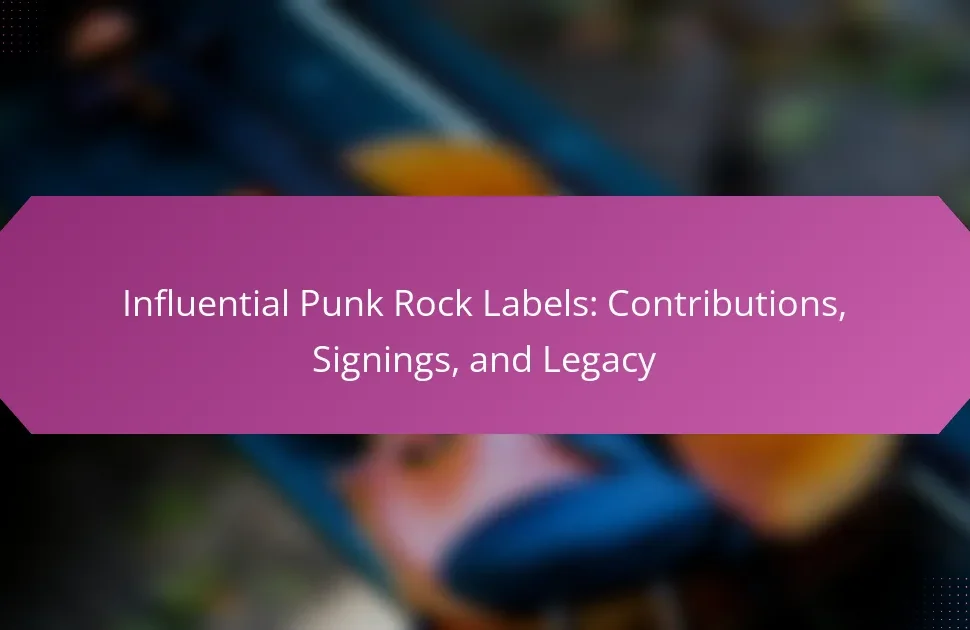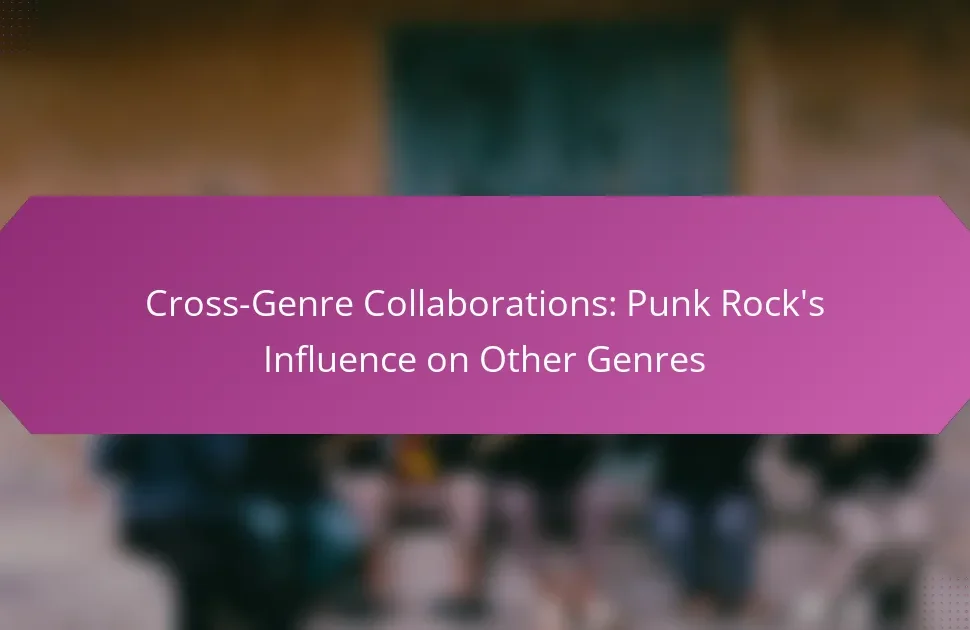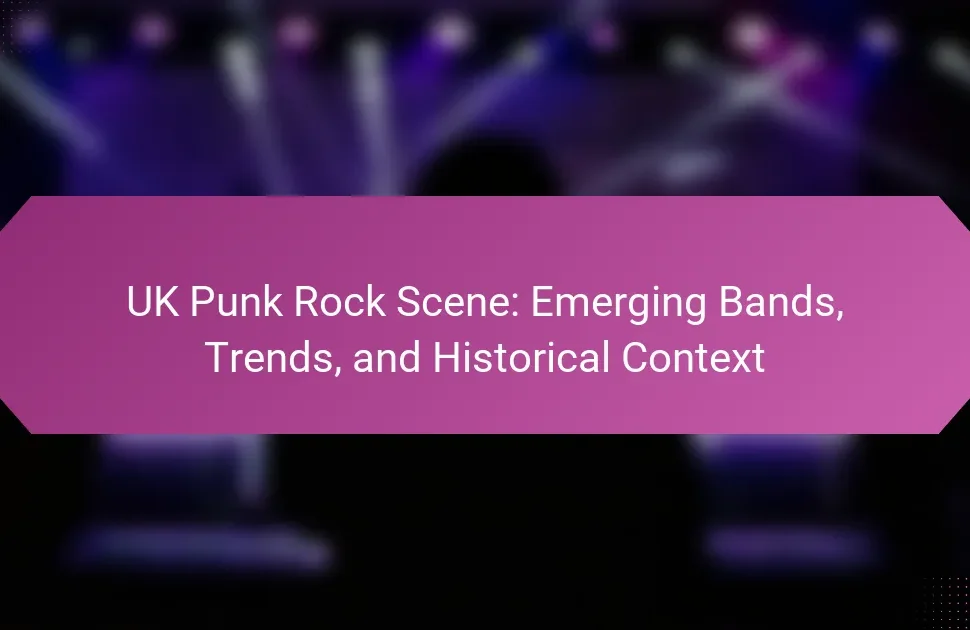Punk rock subgenres offer a diverse musical landscape that reflects cultural shifts and individual expression. Explore the distinct sounds and themes of hardcore punk, pop punk, and post-punk. Discover the influential bands that shaped these subgenres and their unique characteristics. Understand the misconceptions surrounding punk rock and the ongoing evolution of its various forms.
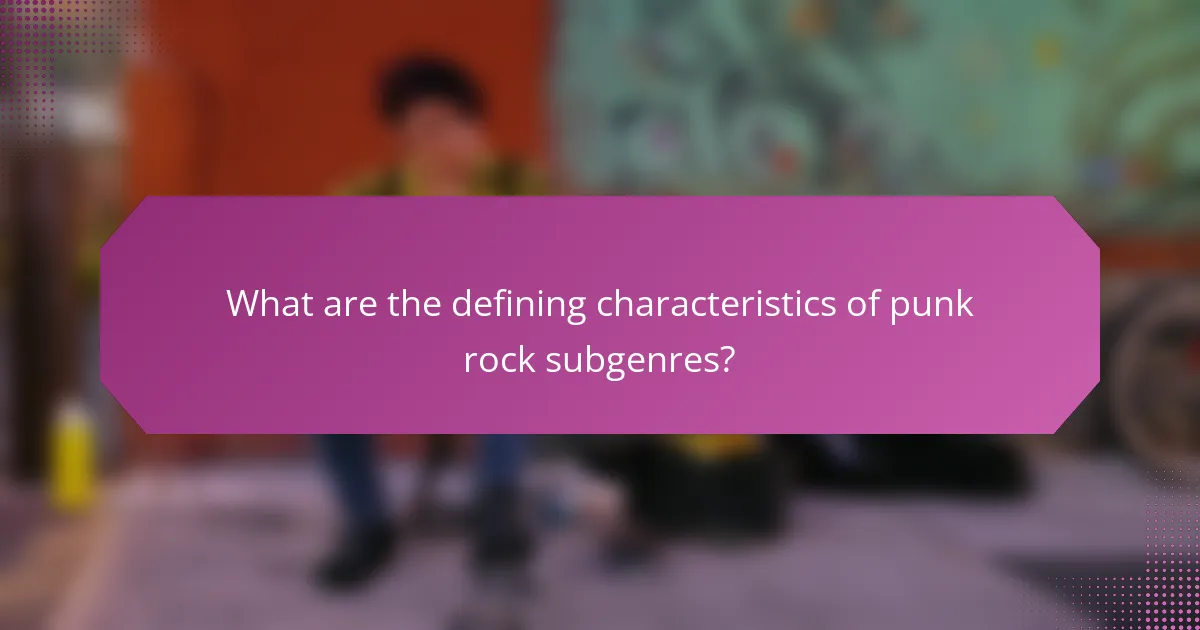
What are the defining characteristics of punk rock subgenres?
Punk rock subgenres are defined by their distinct sounds, themes, and cultural influences. Key characteristics include aggressive music styles, anti-establishment lyrics, and a DIY ethic.
Notable subgenres like hardcore punk emphasize speed and intensity, while pop punk incorporates catchy melodies. Post-punk explores experimental sounds, and ska punk blends punk with reggae rhythms. Each subgenre reflects unique cultural contexts and influences from various musical traditions.
Influential bands such as The Ramones, Bad Brains, and Green Day exemplify these characteristics, shaping the evolution of punk rock. Their contributions highlight the diversity within the punk rock umbrella, showcasing a range of attitudes and musical approaches.
How do punk rock subgenres differ in sound and style?
Punk rock subgenres differ significantly in sound and style, reflecting varied influences and cultural contexts. Each subgenre showcases unique attributes, such as tempo, instrumentation, and lyrical themes.
For example, Hardcore punk features faster tempos and aggressive vocals, while Pop punk incorporates catchy melodies and more mainstream appeal. Post-punk introduces experimental sounds and complex arrangements, diverging from traditional punk’s simplicity.
Notable bands exemplifying these differences include Black Flag for Hardcore punk, Blink-182 for Pop punk, and Joy Division for Post-punk. These distinctions create a rich landscape within the punk rock genre, appealing to diverse audiences.
What lyrical themes are prevalent across various subgenres?
Punk rock subgenres feature lyrical themes that often revolve around rebellion, social issues, and personal struggles. Common themes include anti-establishment sentiments, political commentary, and critiques of consumerism.
Subgenres like hardcore punk emphasize aggression and urgency, while pop punk often explores themes of youth and relationships. Emo punk focuses on emotional expression and vulnerability, contrasting with the more straightforward messages of traditional punk.
These themes reflect the diverse experiences and attitudes within the punk rock community, showcasing a range of perspectives from personal to societal. Influential bands across these subgenres have shaped and defined these lyrical themes, making them integral to the genre’s identity.
Which instruments are commonly used in different punk rock subgenres?
Punk rock subgenres utilize a variety of instruments, primarily electric guitars, bass guitars, and drums. Additional instruments like keyboards and brass may appear in specific subgenres.
For example, in pop punk, catchy guitar riffs and upbeat drums dominate. Hardcore punk emphasizes aggressive guitar and rapid drumming. Ska punk incorporates brass instruments, adding a distinct sound. Each subgenre adapts traditional rock instruments to create unique characteristics.
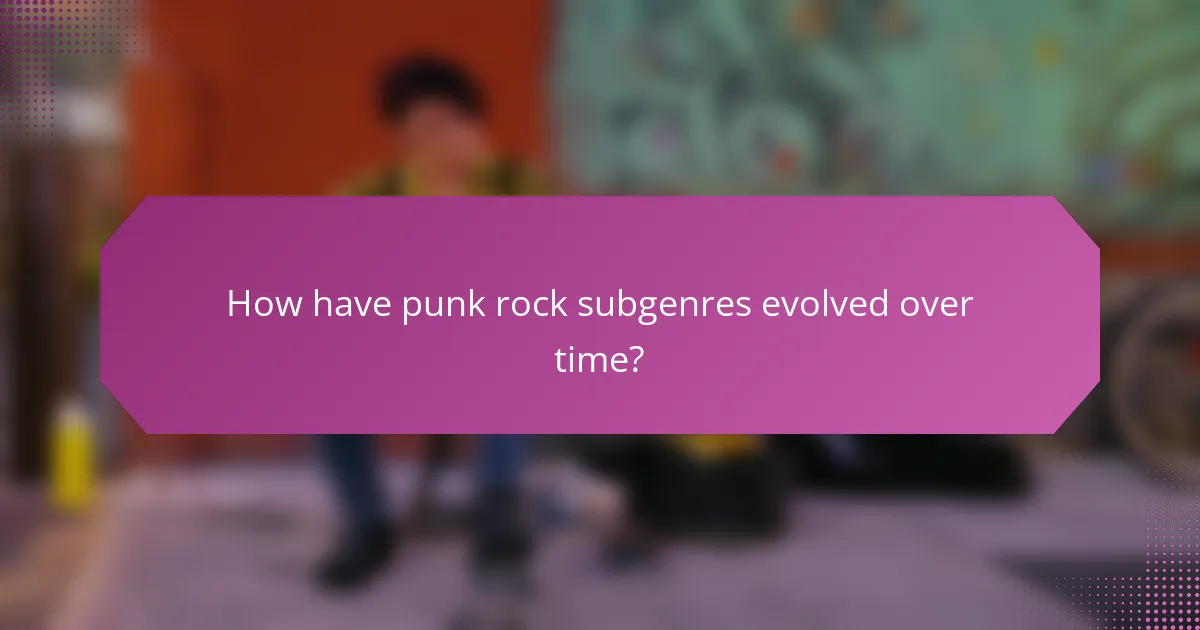
How have punk rock subgenres evolved over time?
Punk rock subgenres have evolved significantly, reflecting cultural shifts and musical experimentation. Early punk laid the foundation, while subgenres like hardcore, pop-punk, and post-punk emerged, each with unique characteristics.
Hardcore punk, known for its aggressive sound and fast tempos, gained prominence in the late 1970s. Bands like Black Flag and Minor Threat exemplified this raw energy. Pop-punk, characterized by catchy melodies and a more commercial appeal, was popularized in the 1990s by bands such as Green Day and Blink-182.
Post-punk introduced more complex sounds and artistic expression, with bands like Joy Division and Talking Heads pushing boundaries. Each subgenre reflects a unique cultural context, showcasing punk’s adaptability and enduring influence.
Overall, the evolution of punk rock subgenres illustrates a rich tapestry of musical innovation, driven by diverse influences and the desire for self-expression.
What historical events influenced the emergence of specific subgenres?
Historical events such as the 1970s punk movement and socio-political unrest shaped punk rock subgenres. The emergence of subgenres like hardcore punk and pop punk reflected reactions to mainstream culture and personal expression. The rise of DIY ethics and the influence of bands like The Ramones and Black Flag further diversified the genre. Additionally, regional scenes, such as the UK punk scene, introduced unique sounds and themes, contributing to the evolution of punk rock.
How did regional scenes shape the development of punk rock subgenres?
Regional scenes significantly influenced the development of punk rock subgenres by fostering distinct sounds and cultural identities. Cities like New York, London, and Los Angeles became epicenters, each giving rise to unique styles such as hardcore, pop-punk, and post-punk. These local scenes shaped the characteristics of the music, from the aggressive energy of hardcore in California to the melodic hooks of pop-punk in the Midwest. Influential bands like The Ramones, Sex Pistols, and Bad Religion emerged, each reflecting their regional influences. This diversity in punk rock showcases how geography and culture can shape musical evolution.
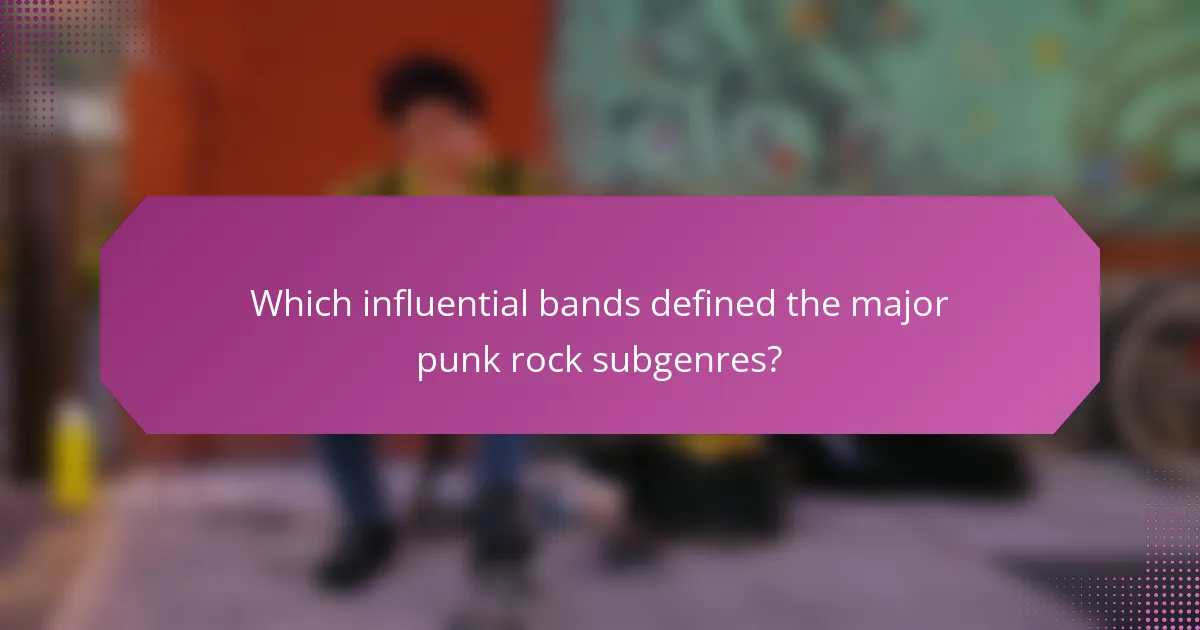
Which influential bands defined the major punk rock subgenres?
Punk rock subgenres have been shaped by influential bands that defined their unique sounds. Key bands include The Ramones for punk rock’s raw simplicity, Sex Pistols for their rebellious attitude, Bad Brains for their fusion of punk and reggae, and Green Day for popularizing pop punk. Each band contributed distinct characteristics, establishing the foundations of their respective subgenres.
What impact did bands like The Clash have on punk rock’s evolution?
The Clash significantly shaped punk rock’s evolution by infusing diverse musical styles and addressing social issues. Their innovative approach merged punk with reggae, rockabilly, and ska, broadening the genre’s appeal. The band’s politically charged lyrics and energetic performances inspired future punk bands to explore themes of rebellion and social justice. This unique attribute of blending genres set a precedent, influencing subgenres like post-punk and pop-punk. As a result, The Clash became a pivotal entity in punk rock, ensuring its relevance and adaptability in the music landscape.
How did Green Day popularize pop-punk in the 1990s?
Green Day popularized pop-punk in the 1990s by blending catchy melodies with punk’s raw energy. Their album “Dookie” achieved widespread acclaim, selling over 10 million copies. This success introduced a new generation to the genre. Green Day’s relatable lyrics and energetic performances helped define pop-punk’s identity, influencing countless bands. Their unique ability to combine humor and social commentary set them apart, making them a cornerstone of 1990s music culture.

What are the unique attributes of lesser-known punk rock subgenres?
Lesser-known punk rock subgenres possess unique attributes that distinguish them from mainstream punk. These subgenres often incorporate diverse musical influences and thematic elements.
One unique attribute is the fusion of genres, such as ska punk, which blends punk with ska rhythms. Another is the lyrical focus on niche topics, like political commentary in anarcho-punk. Additionally, some subgenres, such as pop punk, emphasize catchy melodies and mainstream appeal, while others, like crust punk, adopt a raw, aggressive sound.
Rare attributes include the use of unconventional instruments in genres like folk punk. Influential bands often shape these subgenres, such as The Distillers in punk rock and Against Me! in folk punk, highlighting their distinctive characteristics.
How does post-punk differ from traditional punk rock?
Post-punk diverges from traditional punk rock through its experimental sound and diverse influences. Traditional punk rock emphasizes raw energy and simplicity, while post-punk incorporates art rock, electronic music, and complex structures. Influential bands like Joy Division and Talking Heads exemplify this genre’s innovative approach, often addressing introspective themes and artistic expression. The unique attribute of post-punk is its focus on atmosphere and mood, contrasting with punk rock’s straightforward aggression. This evolution reflects a broader cultural shift in music during the late 1970s and early 1980s.
What defines the sound of ska punk and its cultural significance?
The sound of ska punk is defined by its fusion of upbeat ska rhythms and punk rock’s raw energy. This genre blends fast-paced guitar riffs, brass instrumentation, and socially conscious lyrics, making it a powerful cultural force.
Ska punk emerged in the late 1970s and gained popularity in the 1990s, with bands like Reel Big Fish and Less Than Jake leading the movement. The unique attribute of ska punk lies in its incorporation of reggae influences, creating a distinctive sound that encourages audience participation through dance.
Culturally, ska punk promotes themes of unity and resistance against societal issues. Its energetic performances and community-oriented message resonate with youth, fostering a sense of belonging. This genre’s ability to address social concerns while maintaining an upbeat vibe has solidified its significance in both music and cultural discourse.
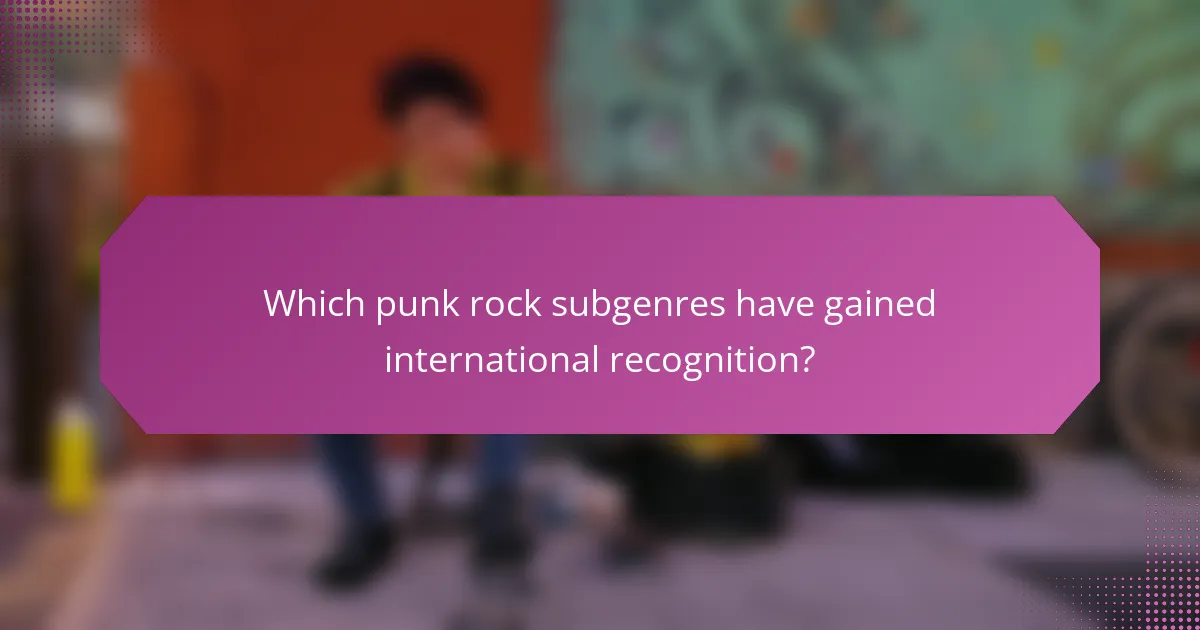
Which punk rock subgenres have gained international recognition?
Punk rock subgenres that have gained international recognition include pop punk, hardcore punk, and post-punk. Pop punk blends catchy melodies with punk’s raw energy, featuring bands like Green Day and Blink-182. Hardcore punk emphasizes speed and aggression, with influential groups such as Minor Threat and Black Flag. Post-punk experiments with sound and style, represented by bands like Joy Division and The Cure. Each subgenre has contributed uniquely to the global punk rock landscape.
How has Japanese punk rock influenced global punk scenes?
Japanese punk rock has significantly influenced global punk scenes by introducing unique sounds and cultural elements. Its distinct characteristics, such as fast tempos and raw energy, have inspired countless bands worldwide. Notable Japanese bands like The Stalin and Shonen Knife have shaped the genre, highlighting themes of rebellion and social critique. As a result, these influences have led to the emergence of various subgenres, blending traditional punk with local styles across the globe.
What role does UK punk play in the global punk landscape?
UK punk significantly shapes the global punk landscape through its distinctive characteristics and influential bands. Originating in the 1970s, UK punk introduced a raw sound and socio-political themes that resonated worldwide. Bands like the Sex Pistols and The Clash not only defined the genre but also inspired countless subgenres, including pop-punk and post-punk.
The DIY ethos prevalent in UK punk encouraged global movements, fostering local scenes in various countries. This unique attribute of grassroots organization empowered bands to emerge independently, influencing punk’s evolution. UK punk’s impact is evident in its lasting legacy, shaping attitudes and music styles across continents.
As a result, UK punk remains a cornerstone of the global punk identity, continuously inspiring new generations of musicians and fans. Its ability to adapt while maintaining core values exemplifies its enduring relevance in the music landscape.
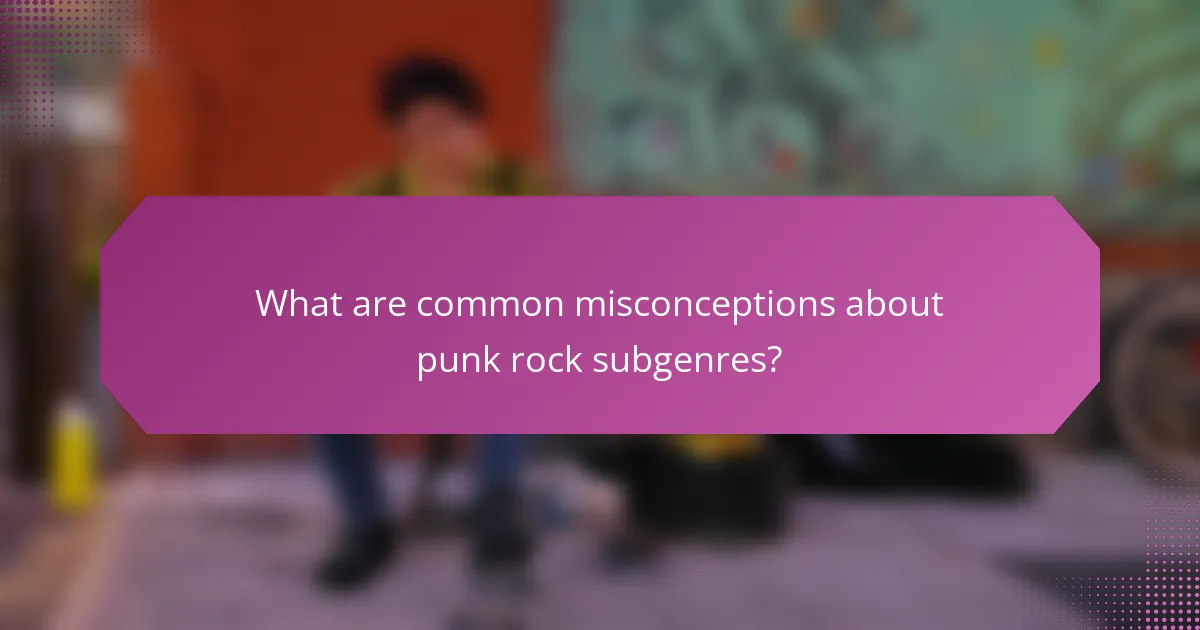
What are common misconceptions about punk rock subgenres?
Many misconceptions exist about punk rock subgenres, primarily due to their diversity and evolution. One common belief is that all punk rock is aggressive and chaotic; however, subgenres like pop-punk and melodic punk emphasize catchy melodies and emotional themes. Another misconception is that punk is solely a male-dominated scene, while numerous influential female artists and bands have significantly shaped its landscape. Additionally, some people think that punk rock is outdated, but it continues to inspire contemporary artists across various genres. Understanding these nuances clarifies the rich tapestry of punk rock subgenres and their cultural impact.
How do stereotypes affect the perception of punk rock culture?
Stereotypes significantly shape the perception of punk rock culture, often portraying it as rebellious and anti-establishment. These views can overshadow the genre’s rich diversity and nuanced subgenres. For instance, the association of punk rock with aggression may alienate those who appreciate its artistic and social commentary aspects. Additionally, stereotypes can limit recognition of influential bands that have contributed to various subgenres, such as pop-punk or post-punk. This narrow lens often overlooks the culture’s emphasis on individuality and community, which are central to its identity.
What are the differences between punk rock and other rock genres?
Punk rock differs from other rock genres through its raw energy, fast tempos, and anti-establishment lyrics. Unlike mainstream rock, punk emphasizes simplicity and often eschews complex instrumentation. Punk subgenres like hardcore and pop-punk showcase unique attributes, such as aggressive styles or catchy melodies. Influential bands like The Ramones and The Sex Pistols exemplify these characteristics, setting punk apart from softer rock variations like soft rock or progressive rock.

What practical tips can enhance the appreciation of punk rock subgenres?
Listening to diverse punk rock subgenres enhances appreciation through exploration and understanding of their unique characteristics. Engage with influential bands to grasp the evolution of the genre. Attend live shows to experience the energy firsthand. Explore subgenre-specific playlists to discover hidden gems. Read literature and documentaries to gain deeper insights into the cultural context and impact of punk rock.
How can listeners explore new subgenres effectively?
Listeners can explore new punk rock subgenres effectively by engaging with various music platforms and communities. Start by utilizing streaming services that offer curated playlists featuring specific subgenres. Follow influential punk rock bands on social media to stay updated on new releases and trends. Participate in online forums and attend local shows to connect with other fans who can share recommendations. Additionally, reading music blogs and magazines can provide insights into the characteristics and history of different subgenres. This approach helps listeners discover unique sounds and influential bands within the punk rock landscape.
What are the best practices for supporting local punk rock scenes?
Supporting local punk rock scenes involves fostering community engagement, promoting local bands, and organizing events. These practices enhance visibility and strengthen connections among fans and musicians.
Encouraging collaboration between bands can lead to unique performances and cross-promotion. Hosting regular shows in accessible venues increases attendance and attracts diverse audiences.
Utilizing social media platforms to share local music and events amplifies reach. Engaging with fans through interactive content can build a loyal community.
Lastly, establishing partnerships with local businesses can provide mutual benefits. Sponsorships or promotions can help sustain the scene and create a vibrant local culture.

